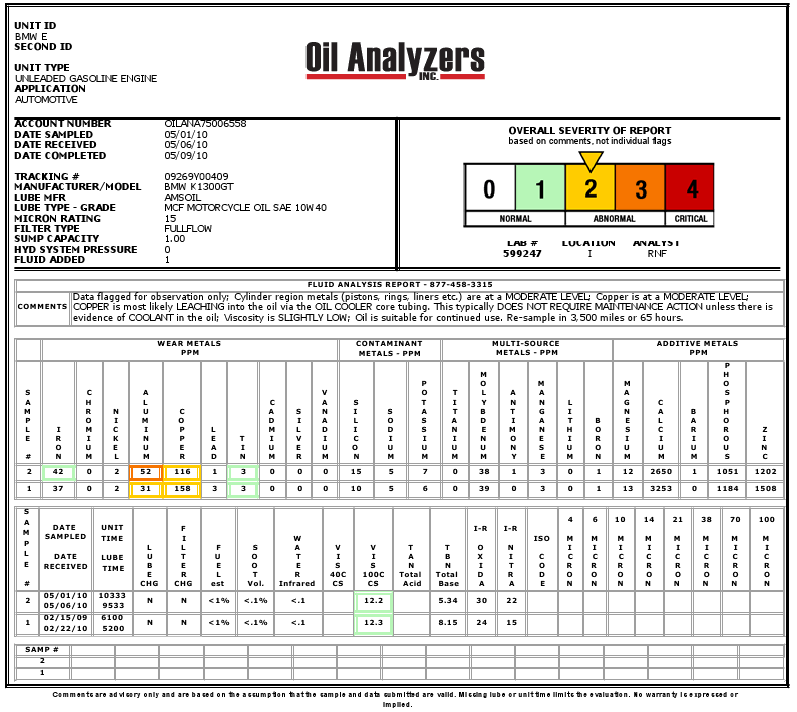Here's the first UOI for my K1300GT. Factory service interval is set at 6000 miles. I intend to have a UOI run at every scheduled service interval, and every recommended re-test interval, as per the results of the UOI.
I intend to run a 12000 mile extended drain interval, UOA results permitting.
The K1300GT has a 3.5 liter total oil capacity, and takes 10w40 weight oil. I broke this engine in on Highway 84 and Skyline (popular motorcycle roads in the California Bay Area,) intentionally accelerating hard and engine braking, as per the MotoMan Approach.
The factory fill was scheduled to be changed out at 600 miles, but was actually changed at 800 miles due to the holidays (my oil guy wouldn't answer his phone on Christmas day. Go figure.
The factory fill was exchanged for Amsoil 10w40 MCV Motorcycle Oil - this contradictory to MotoMan's recommendations.

Here are the comments from the Oil Analysis:
Quote:
Data flagged for observation only; Copper is at a MODERATE LEVEL; COPPER is most likely LEACHING into the oil via the OIL COOLER core tubing. This COMMENTS typically DOES NOT REQUIRE MAINTENANCE ACTION unless there is evidence of COOLANT in the oil; Piston metal is at a MODERATE LEVEL; Viscosity is SLIGHTLY LOW; Oil is suitable for continued use. Re-sample in 3,500 miles or 65 hours.
The viscosity grade of the oil has degraded slightly below 40 weight, and is now near the top end of the 30 weight viscosity range. Although a little low, the oil is still within an acceptable viscosity for this engine.
Not currently concerned about the piston wear metals - they may be remnants of the initial break in (about .25 liters of the factory fill are still in the engine. An oil change never removes everything.) Or, they engine may still be wearing in. Additional UOAs will help identify their source.
I'll take another sample at 9600 miles and post the results.
I intend to run a 12000 mile extended drain interval, UOA results permitting.
The K1300GT has a 3.5 liter total oil capacity, and takes 10w40 weight oil. I broke this engine in on Highway 84 and Skyline (popular motorcycle roads in the California Bay Area,) intentionally accelerating hard and engine braking, as per the MotoMan Approach.
The factory fill was scheduled to be changed out at 600 miles, but was actually changed at 800 miles due to the holidays (my oil guy wouldn't answer his phone on Christmas day. Go figure.
The factory fill was exchanged for Amsoil 10w40 MCV Motorcycle Oil - this contradictory to MotoMan's recommendations.

Here are the comments from the Oil Analysis:
Quote:
Data flagged for observation only; Copper is at a MODERATE LEVEL; COPPER is most likely LEACHING into the oil via the OIL COOLER core tubing. This COMMENTS typically DOES NOT REQUIRE MAINTENANCE ACTION unless there is evidence of COOLANT in the oil; Piston metal is at a MODERATE LEVEL; Viscosity is SLIGHTLY LOW; Oil is suitable for continued use. Re-sample in 3,500 miles or 65 hours.
The viscosity grade of the oil has degraded slightly below 40 weight, and is now near the top end of the 30 weight viscosity range. Although a little low, the oil is still within an acceptable viscosity for this engine.
Not currently concerned about the piston wear metals - they may be remnants of the initial break in (about .25 liters of the factory fill are still in the engine. An oil change never removes everything.) Or, they engine may still be wearing in. Additional UOAs will help identify their source.
I'll take another sample at 9600 miles and post the results.
Last edited:

